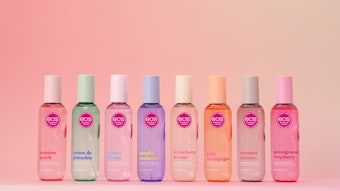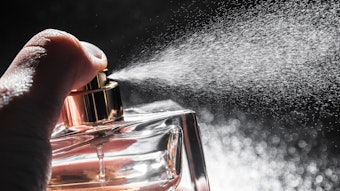Editor’s note: This article is the conclusion of an article that ran in the July/August 2014 issue of GCI magazine.
Michael Edwards, author of “Fragrances of the World” reference books, recorded only 85 fine fragrance introductions in 1989. In the 1990s, however, the industry experienced a large growth in women’s fragrance introductions, mostly concentrated within the fruity floral family. (Edwards’ classifications of scents have evolved over the years, and currently include floral, soft floral, floral oriental, soft oriental, oriental, woody oriental, woods, mossy woods, dry woods, aromatic fougère, citrus, water, green and fruity.) Meanwhile, fresh fougères were the go-to for men. Classics such as Beautiful, Happy, Eternity and Romance for women and Eternity and Cool Water for men were introduced, and have maintained healthy shares for years. Why? They are expertly formulated, high-quality fragrances that connected emotionally to consumers and have maintained that connection over time.
From a historical perspective, there will always be certain fragrances that disrupt the current landscape. For the 1990s, the disruptive fragrances were CK One, Angel and Cashmere Mist for women, and Aqua di Gio and Le Male for men. All of these fragrances are still bestsellers today. Once the 2000s came about, new launches kept the momentum for growth. Fruity florals were still the dominant category for women, even though we saw a few notable newcomers in the floral oriental and chypre categories, with disruptors including Narcisso Rodriguez and Coco Mademoiselle. The same momentum continued for fresh fougères for men, with some growth in the woody category, including disruptors such as Dior Pour Homme, Terre d’Hermès and Armani Code.
There is always a need for disruptors to shake things up and bring uniqueness, signature and relevance to the marketplace, while inspiring others to follow, thereby expanding the olfactive range for consumers who were most likely very ready for something new. According to Edwards’ documentation of fragrance launches, it appears that even in the midst of the global recession there were 1,313 launches in 2010.
Fragrance and Brand DNA
Just as each of us has our own uniqueness and identity, fragrance brands do as well. I have had fragrance development experience in what I believe to be almost all end-uses in the marketplace, from the most sophisticated fine fragrance brands that contain numerous raw materials to the most simplistic formulas that are incorporated into highly technical and challenging bases for toilet bowl cleaners and other functional care products, including air fresheners.
Through my experience, fine fragrance development and evaluation can be a much more tedious process than that of developing a scent for household products, especially considering that licenses are often involved. More layers of involvement equals increased sensitivities and complexities. I often smell as many as 50 formulations a day, and quite often there could be one fragrance theme with several modifications off that theme. We in the fine fragrance category smell on multiple skin types and off of blotters to judge diffusivity, longevity, overall strength and balance, compared to temperature- and humidity-controlled air freshener booths, or specifically regulated guidelines for the various stages of the laundry process. The DNA of the celebrity or fashion brands is already established before the development process, but the concepts and the “stories” being told have to be communicated by the structure and the “feel” of the fragrance.
Even though it appears that celebrity fragrances are quite new to the industry, they are not. In the 1980s, Catherine Deneuve, Cher and Sofia Loren had their own perfumes, and, in 1991, Elizabeth Taylor’s White Diamonds was launched, becoming the top-seller in mass market fragrances for more than a decade. Celebrities have their own specific consumer targets. All have diverse olfactive and cultural differences, but there is only one Jennifer Lopez, one Beyoncé and one Britney Spears. The task for the perfumers and developers is to know and understand the celebrities’ consumers and create fragrances that appeal to them.
I have worked with quite a few celebrities who have launched fragrances—Celine Dion, Beyoncé, Halle Berry and Katy Perry, to name a few. When I meet with a celebrity for the first time, my task is to get to know them as a human being, not as the celebrity that I read about online or in publications. I always start by taking my client through exercises from which I discover and analyze their olfactive likes and dislikes. It is of utmost importance that I build trust and a good working relationship with the celebrities, because my overall goal is to be able to walk away from that meeting able to communicate to perfumers an olfactive direction that will be in harmony with marketing’s concept; the target consumers’ tastes from one market to another across the globe; and, in the end, be a fragrance that my client will approve to go forward for launch.
Many of the celebrity fragrances have to exude sexiness, but the overall “feel” and sexiness can vary from one celebrity to the next. For example, fragrances created for Halle Berry and Beyoncé must always be unmistakably sexy in their overall personality, but the sexiness is communicated in very different ways. On the other hand, a Celine Dion fragrance has to communicate romance and elegance because that is what she conveys to her audience through her musical talent. Furthermore, her target market is more mature than a Beyoncé consumer, so all these details go into consideration when designing fragrances. And all of that has to be achieved within the development process before it goes to consumer research.
The same thought process is used for developing fragrances for fashion and lifestyle brands, as each brand has its own identity, and it is my responsibility to communicate the “feel” of that brand via scent. For example, the Guess brand is about a sexy, young and adventurous lifestyle. Jeans are its heritage, so fragrances have to communicate young, hip, sexy and cool. The Nautica brand is all about clothes that are classic, easy to wear and for that everyday kind of guy. Its fragrances are clean, fresh, easy to wear and must always have an olfactive connection within the fragrance to water.
Fragrance brands outside the Coty portfolio that I feel communicate the essence, or the DNA, of that brand would be Jean-Claude Elena’s exquisite creations for Hermès. His fragrances have been in perfect harmony with the Hermès brand, known for its distinguished heritage of elegant accessories and the highest quality of raw materials and workmanship. Elena’s formulas are refined, often delicate and classic with the most superb high-quality raw materials within his formulations. On the other end of the spectrum would be Dolce and Gabanna, whose fashions are for the daring, fashion-forward, young and seductive woman, and their fragrances are always sexy, robust, multifaceted and with a decidedly European (Italian) edge.
Overall, the true challenge in fragrance development is the timing of multiple fragrance launches that occur every six months or so for new flankers or limited editions. (I am often developing several fragrances at the same time.) Much thought and strategy has to come into consideration in order to assure that the DNA of each brand stays intact, while still providing the consumer with an exciting new scent offering.
Challenges on the Perfumery Landscape
Perfumers have all the challenges I have, and many more. The industry is at a point at which regulatory councils restrict and eliminate ingredients that have been utilized in formulations for decades. Global climate change has affected some of perfumery’s natural resources, which causes havoc in supply and demand for major ingredients such as rose, patchouli and sandalwood, which can be challenging and add even more pressure for marketing companies to maintain their margins. The chain reaction that takes place often results in even more stress to the perfumer and the fragrance suppliers because they have to reformulate for multiple reasons. This is life as we know it now, and it’s not going to go back.
Perfumers, who are great time managers, and creatively and technically crafty, will wear the storm well. But the industry can’t let them wear it by themselves. Marketers, fragrance developers, evaluators, sales staff and the perfumers should work smarter and closer together with good communication and cohesive partnerships in order to meet the challenges of the new industry landscape.
Most importantly, we should try and be more mindful of the time given to perfumers to create and make necessary iterations to their formulae before presenting candidates to us. “Burning out” is not healthy for anyone, and definitely not good for creativity and productivity. I once heard a perfumer say, “I feel like a Pez dispenser.” This feeling can’t help the perfumer conceive art, as I believe fragrance is. For a perfumer to produce one formula after another with only a limited amount of time is a disappreciation to the art itself. The goal should not be about the number of formulae produced, but about the “one” that becomes the win. I fully believe that reaching the “one” requires time, a good thought process and often collaboration with another perfumer within the company in order to view the fragrance from a different perspective, and to take the fragrance to its final, fine-tuned stage.
Besides giving perfumers more time and thought for the creative process, it must be the responsibility of the fragrance supply houses to thoroughly understand the philosophy and DNA of the various brands they are accountable for. To those houses I say: Know your brands, understand and know their consumer, and be thorough in the evaluation of your formulae. Yes, blotter/paper evaluations are always a good start, but wearing the fragrance on skin is even more important. If you are working on a brand whose audience consists of African American, Hispanic, Asian and Caucasian populations, make sure you evaluate the fragrances on multiple types of skin.
Forward On We March
The economy, consumer and world markets have changed and evolved, and we need to accept the changes and challenges that have come with it and take action. I often believe that we ignore cues that pop up, thinking that they may just be a passing fad or trend, but social media has taught us lessons that what may have appeared to be just a passing fad was really something that became a worldwide movement.
At the time when the industry talked about going “global,” we believed we could develop and market a fragrance that would automatically and easily expand to other markets around the globe. Now we know better, as we should have. Certain markets have particular cultural and lifestyle differences that need to be accepted, and their needs must be addressed.
For instance, Japan has long been known for having a preference for light, fresh and airy florals. On the other hand, Brazil, which is the leading country for purchases of fragrance in the world, is split into several geographical regions with the two major regions having very different tastes. What they do have in common is a need for a sparkling fresh top notes and a preference for creamy background notes.
It also is now well known that fragrances with high levels of alcohol are subjected to high taxes. Manufacturers either have to pay those high taxes or develop the fragrances accordingly. Composing fragrance for local markets may now be an exception to what was a rule.
I encourage the industry to look beyond the 1,500 or so traditional fragrance ingredients that a perfumer has in his/her palette to utilize for their creations. The following are some examples that I am particularly enamored by, and embrace. Givaudan and Firmenich have made great strides in utilizing sustainable and fairly traded raw materials in their formulas, which enhance and support various communities around the world and add a feeling of “goodness” to a fragrance story. IFF continues to explore and expand on its trademarked Living Flower and Living Fruit technology repertoire. All three fragrance giants strive to invest and invent new molecules for their captive palettes or the open market. Other suppliers, like Robertet, which I’ve always known for its high-quality natural raw materials, consistently invest in sourcing new ingredients, while Symrise has forged ahead to expand on its Life Essentials program, offering new, exciting ingredients to utilize in formulas like never before.
Innovations via delivery systems, raw materials, and new concepts are a must-have in order to help support brand differentiation, and keep “new” truly new. I am also certain there are untapped resources outside of our industry that we have yet to discover, which may be able to inject new ideas that could be healthy for growth. But we have to take the time to do this: Breathe, think, be strategic and then act.
We need to recapture consumers who have left us, and gain new ones who have not yet discovered us. We need them to fall in love, and stay in love with fragrance!
Ruth Sutcliffe built her awareness of scent from a very young age. In a career spanning over 25 years, Sutcliffe has gained expertise in a wide-range of end-uses—including fine fragrance, laundry and air care, and all genres of personal care products. She has held positions including fragrance evaluator at Fritzsche Dodge & Olcott and Creations Aromatiques, and worked in fragrance development at IFF, where she co-authored a patent called NeutrIFF. She later served as a sensory analyst and fragrance developer for Clairol, and now serves as senior marketing director and fragrance designer at Coty where she lends her fragrance expertise in the development of both lifestyle and celebrity brands such as Beyonce, Katy Perry, Celine Dion, Guess and Nautica.










